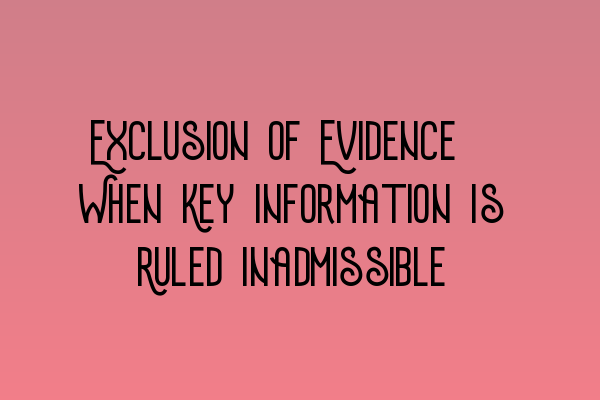Exclusion of Evidence: When Key Information Is Ruled Inadmissible
Welcome to the SQE Criminal Law & Practice blog!
In the world of criminal law, the exclusion of evidence is a crucial aspect that can greatly influence the outcome of a case. When key information is ruled inadmissible, it can have a significant impact on the prosecution or defense’s ability to present their case effectively. In this article, we will delve into the intricacies of excluding evidence and explore the implications it can have on a trial.
Understanding Exclusion of Evidence
Exclusion of evidence refers to the legal process by which certain information or pieces of evidence are deemed inadmissible in court. This can occur for various reasons, including improper handling of evidence, violation of constitutional rights, or unreliable methods of obtaining evidence. The goal of excluding evidence is to ensure fairness and maintain the integrity of the judicial system.
It is essential to understand that the exclusion of evidence can significantly impact the strength of the prosecution or defense’s case. A crucial piece of evidence that is ruled inadmissible can weaken the prosecution’s argument, potentially leading to a dismissal of charges or a reduced sentence. On the other hand, the exclusion of evidence can also hamper the defense’s ability to prove their innocence or undermine the credibility of their case.
Grounds for Excluding Evidence
There are various grounds on which evidence can be excluded, including:
- Unlawful Search and Seizure: If evidence is obtained through an illegal search or seizure, it can be deemed inadmissible. The Fourth Amendment of the Constitution protects individuals from unreasonable searches and seizures by law enforcement.
- Violation of Miranda Rights: If a suspect’s Miranda rights, such as the right to remain silent or the right to an attorney, are violated during the interrogation process, any evidence obtained as a result may be excluded from trial.
- Chain of Custody Issues: If the chain of custody, which ensures the integrity and authenticity of evidence, is broken, the evidence may be excluded. This can occur if there are gaps in the documentation or if there is doubt regarding the handling and storage of the evidence.
- Hearsay: Hearsay refers to an out-of-court statement offered for the truth of the matter asserted. Unless an exception applies, hearsay is generally considered unreliable and is therefore excluded from trial.
These are just a few examples of the grounds on which evidence can be excluded. It is crucial for criminal law practitioners to have a thorough understanding of these grounds and stay updated on recent case law developments to navigate the complexities of excluding evidence effectively.
The Impact on a Trial’s Outcome
The exclusion of key evidence can have a profound impact on the outcome of a trial. It can weaken the prosecution’s case by removing vital pieces of evidence that are necessary to prove guilt beyond a reasonable doubt. Similarly, the defense may find it challenging to present a strong case without certain evidence that could support their arguments or cast doubt on the prosecution’s version of events.
Moreover, the exclusion of evidence can also influence the dynamics of plea negotiations. If the prosecution’s case is significantly weakened due to the exclusion of key evidence, they may be more inclined to offer a favorable plea deal to avoid the risk of losing at trial.
Final Thoughts
The exclusion of evidence is a critical aspect of criminal law that can shape the outcome of a trial. Understanding the grounds for excluding evidence and staying updated on the latest legal developments is crucial for criminal law practitioners. At SQE Criminal Law & Practice, we offer comprehensive preparation courses for the SQE 1 and SQE 2 exams, ensuring future solicitors are well-versed in all aspects of criminal law, including the exclusion of evidence.
To further enhance your knowledge, we recommend checking out our related articles:
- SQE 1 Practice Exam Questions
- SQE 1 Practice Mocks FLK1 FLK2
- SQE 2 Preparation Courses
- SQE 1 Preparation Courses
- SRA SQE Exam Dates
We hope you found this article informative. If you have any questions or would like to learn more, please don’t hesitate to contact us.
Stay tuned for more insightful articles from SQE Criminal Law & Practice!
